Szerkesztő:Milei.vencel/Ring
A gyűrű egy karika alakú, fémből vagy más anyagból készült ékszer viselnek. A kifejezés önmagában mindig a kéz ujjain viselt ékszereket jelöli; ha máshol viselik, akkor a testrész is van megadva, például fülbevaló, orrkarika, kargyűrű vagy lábujjgyűrű stb. A gyűrűk mindig szorosan illeszkednek a test vagy a testrész köré, amelyet díszítenek, így a lazán viselt tárgyak, mint például egy karkötő, nem gyűrű. A gyűrűk szinte bármilyen kemény anyagból készülhetnek: fából, csontból, kőből, különféle fémből, üvegből, drágakőből vagy műanyagból. Díszíthetők drágakövekkel ( gyémánt, rubin, zafír, smaragd) vagy más kővel vagy üveggel.
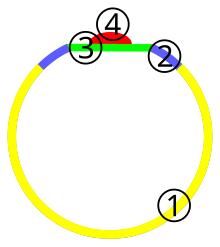
[szerkesztés]
A legrégibb gyűrűket [1] és más hasonló ékszereket, beleértve a nyakláncokat, orrkarikákat, karkötőket, fülbevalókat, karpereceket és medálokat, az Indus-völgyi civilizáció Kr. E. 3. évezredéből fedezték fel, a ma Indiához tartozó Lothalban . [2]
Az iraki Ur sírjaiban olyan ujjgyűrűket találtak, amelyek Kr. E. 2500 körül készültek. [3] A hettita civilizáció is készített gyűrűket, beleértve a pecsétgyűrűket is, amelyek közül néhányat megtaláltak. Az Egyiptomi Óbirodalomban élő emberek különféle ujjgyűrűket viseltek, amelyekre néhány példát találtak, köztük a híres skarabeum mintát . A gyűrűk az Egyiptomi Középbirodalom idején egyre gyakoribbá váltak, és egyre összetettebb mintákat tartalmaztak. Az egyiptomiak nemcsak fémgyűrűket, hanem fajansz gyűrűket is készítettek, amelyek közül néhányat újévi ajándékként használtak. [4] Az őshonos stílusokat a Ptolemaiosz-dinasztia idején a görög és a római divat váltotta fel. [5]
Az ókori görög gyűrűket bizonyos mértékben befolyásolták az egyiptomi gyűrűk, bár általában kevésbé voltak jelentősek, és általában nem használták őket jelző (signet) gyűrűként. Mivel az arany helyben nem volt elérhető, a keleti gyarmatokon készült gyűrűk általában ezüstből és bronzból készültek, míg az etruszkok aranyat használtak a készítéséhez. [6]

A korai és középső római császári korszakban (1-2. század) egy tipikus római gyűrű vastag karikából állt, amely közvetlenül egy kissé szélesebb keretbe szűkül. Egy vésett ovális drágakő kerül beágyazásra a keretbe, és a drágakő teteje csak kissé emelkedik a környező gyűrűs anyag fölé. Az ilyen gyűrűk hivatalos tudományos szóhasználatban Henig II és III / Guiraud 2 néven ismertek, vagy egyszerűen a modern ékszerészek római gyűrűiként. [7] Általában a római gyűrűk a 3-4. században lettek bonyolultabbak (more elabote). [8]
A középkori Európában divatos volt, hogy több gyűrűt viseltek mindkét kéz ujjain. A gyűrűk ebben az időszakban többnyire rézalapú ötvözetekből, ezüstből vagy aranyból készültek. A drágakövek 1150 után váltak általánossá, azzal a meggyőződéssel együtt, hogy bizonyos drágakövek képesek különböző módon segíteni vagy megvédeni viselőjét. A vésett (engraved) gyűrűket lombardiai írásmóddal állították elő kb. 1350-ig, míg a gótikus írás fel nem váltotta . Néhány felirat odaadó, mások romantikus jellegű volt. A romantikus feliratok esetében a francia volt a választott nyelv. [9] A szerződések és más, hivatalos pecsétet igénylő dokumentumok egyre növekvő használata azt jelentette, hogy a pecsétgyűrűk a 13. századtól kezdve egyre fontosabbá váltak. [10]
Stílusok[szerkesztés]
Több ezer éves gyűrűgyártás után a készített stílusok száma óriási.
| Ring | Image | Usage |
|---|---|---|
| Aqiq ring | A carnelian or agate ring worn by some Muslims in imitation of Muhammad. | |
| Birthstone ring | Usually a slender, simple ring (sometimes consisting of a band), set with the wearer's birthstone or the birthstone of the wearer's spouse. Such birthstone rings as the Mother's ring can be worn set with various birthstones. Some couples wear birthstones set with a wedding anniversary month birthstone as well as other commemorative stones. | |
| Cameo (carving) ring | 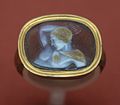
|
A plain hoop mounted by a table setting, into which is affixed a carved cameo. This ring style is exceedingly ancient and was more commonly worn by men than women. Ancient cameos depicted pagan gods, Christian saints and even self-portraits. Multi-coloured stone and often marble or porphyry was most desirable, as it produced a striped, layered or three-dimensional effect. The modern cameo ring usually shows the profile of a goddess or a Roman soldier. |
| Bajnoki gyűrű | 
|
A bajnoki gyűrű vagy a premier gyűrű az a gyűrű, amelyet az észak-amerikai profi sportligák és főiskolai bajnokságok győztes csapatainak tagjai kapnak. |
| Claddagh ring | 
|
A Claddagh gyűrű olyan hagyományos ír gyűrű, amely a szeretetet, a hűséget és a barátságot képviseli (a kezek a barátságot, a szív a szeretetet, a korona pedig a hűséget jelenti). |
| Class ring | 
|
Worn by students and alumni in commemoration of their graduation. |
| Cocktail ring | An oversized ladies' ring with a large center stone often surrounded by tiny stones. Nearly any oversized ladies' ring may be termed "cocktail". This is the most common type of costume jewellery ring and is also known as a cluster ring, statement ring and/or dinner ring.[11] | |
| Doctoral ring | 
|
A gold ring worn by a scholar who earns a doctoral degree at a Danish or Swedish university. In America it is common for priests who have earned their doctorate in theology to wear such a ring on the ring finger of their right hand. |
| Egyházi (püspöki) gyűrű | 
|
A religious ring, either of authority for clerics or as some other special religious symbol. When worn by bishops or higher-ranking priests, it is called "Episcopal ring". |
| Engagement ring | 
|
A ring was given to and worn by a woman signifying her engagement to be married. |
| Eternity ring | 
|
A ring symbolizing eternity with a partner. These are often given in lieu of engagement rings, as when former UK Prime Minister Gordon Brown purchased one for his wife (as a recompense for not having originally proposed to her with an engagement ring).[12] |
| Fede ring | 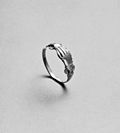
|
A ring style featuring two clasped hands. |
| (Bague armure) | 
|
A ring style which spans from the base of the finger to just below the fingernail or middle of the second joint. This type of ring includes a bending joint. |
| Gay Pride ring (a.k.a. "Rainbow ring") | Representing gay pride, a ring which is usually a band, either set with seven stones or inlaid with seven enamelled lines, in the seven colours representing the Rainbow flag (LGBT movement). In decades past, a stone-set ring worn on the right hand ring finger or the pinky of either hand represented a call for gay equality.[forrás?] | |
| Giardinetti ring | 
|
Italian for 'little garden' a design which features an openwork bezel containing multiple small stones. It was most prominent in the second half of the 18th century.[13] |
| Gimmal ring | 
|
Ring made of 2 or 3 hoops that are hinged at the back and meant to interlock and open; popular for betrothals in 16th- and 17th-century Europe |
| Guard ring (a.k.a. ring-guard) | A slender, slightly tighter-fitting ring designed to be placed on the finger after a large/loose ring, to prevent slippage and ring loss.[forrás?] | |
| Iron Ring, and Engineer's Ring | 
|
Ring worn by American and Canadian engineers, after swearing the Engineer's Oath. This is often in the form of a crudely worked piece of iron; modern rings tend to be sleek steel, some with etched geometric designs. The ring is meant to be worn on the pinky (little) finger of the dominant hand at all times. This ring has been loosely associated with Rudyard Kipling. |
| Key ring | 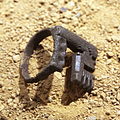
|
A ring with a key mounted on the bezel. Used by the Romans as both a means of carrying a key to their family valuables chest and to demonstrate their status within the family.[14] |
| Memento mori ring | 
|
Largely dating from the 16th to the 17th centuries, memento rings featured a skull and the inscription Memento Mori (“Remember Death”) sometimes combined with other features.[15] |
| Mood ring | 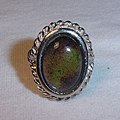
|
A novelty ring which changes colour in response to body temperature, using a thermochromic liquid crystal. |
| Mother's ring | A ring worn by a mother displaying the birthstone of each of her children, and sometimes including those of the mother and father.[forrás?] | |
| Mourning ring | 
|
A ring worn in memory of someone who has died.[16] Also commonly called a "memorial ring". Use attested from at least the 14th century AD to the late 19th century. |
| Multi-finger ring | Two or more laterally conjoined rings, designed to be worn on two, three, or four fingers; popularized by hip-hop culture.[forrás?] | |
| Penannular ring | 
|
Found in gold or gilded metal from Bronze Age Britain, these small thick incomplete circles are the wrong size and shape to be finger-rings and were probably worn as nose or ear-rings or attached to the hair or clothing. |
| Poison ring | A ring consisting of a bezel with a compartment. Despite the name they were probably more commonly used to hold things like perfume or romantic keepsakes.[17] | |
| Posie ring | 
|
A ring with a lengthy inscription on its outer surface. These were commonly used as engagement and wedding rings. Also referred to as "posy" or "poesy" rings in reference to the line of poetry most commonly used in the inscription. |
| Portrait ring | 
|
Ring with a small portrait, most common during the 17th century |
| Pre-engagement ring | A small, inexpensive ring given to a partner, signifying the promise not to court anyone else.[18] | |
| Prison ring | A typically plastic ring fashioned by hand in prisons.[19] | |
| Promise ring | A ring worn to remind a person of a promise. These evolved in conjunction with wedding and religious vow rings in the sense that the ring represented the vow/promise. | |
| Purity ring | 
|
A symbol of virginity and a vow to keep virginity in some religious cultures. |
| Puzzle ring | 
|
Interlocking rings forming a single band. A famous example is the classic Cartier "Trinity" wedding ring. |
| Regards ring | A Victorian engagement ring with an implicit acrostic: Ruby, Emerald, Garnet, Amethyst, Ruby, Diamond, Sapphire. | |
| Rosary ring | 
|
Also known as a Decade ring.[20] Ring worn around the finger with 10 indentations (or protrusions) and a cross as a bezel, representing one decade of a rosary. The rings are used to keep track of place in the prayer by rotating the ring on a finger and feeling the marks. |
| Sewing ring | 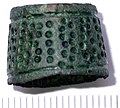
|
An early form of thimble |
| Signet ring | 
|
An emblematic ring, often bearing a family coat of arms, some of which are fit for use to imprint a wax seal. In the event a seal or at least a representation of a seal is on the ring, it is called a "seal ring". The signet may bear anything from a custom-designed escutcheon to simple initials, in which case it is known as an initial ring. |
| Sovereign ring | A large solid gold ring set with a gold sovereign.[forrás?] | |
| SS-Ehrenring | Nazi "honor ring" or "ring of honor". A plain silver band decorated with a death's head. Awarded to members of the Nazi SS (Schutzstaffel). A similar ring (in the form of a death's head) was also favored by the SS-SD (Schutzstaffel-Sicherheitsdienst) and was very secretive in design. There were in fact several different award rings during the Third Reich.[21] | |
| Technology ring | The Technology ring is worn in Canada by certified engineering and applied science technologists and technicians.[22] Like an Iron Ring, it is worn on the little finger of the working (dominant) hand. | |
| Thumb ring | 
|
Originally thumb rings were used as an archery implement, mainly in eastern styles of archery. Thumb rings are an ancient custom. |
| Toe ring | 
|
Toe rings have a particular function in India. They are considered a customary ornament to be worn by married women.[23] |
| Watch ring | 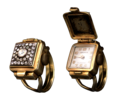
|
A small watch fashioned to be worn as a ring.[forrás?] |
| Wedding ring | 
|
A ring presented at the time of marriage to signify espousal and marital commitment. Originally worn only by women, it is now common for both spouses to wear such a ring. |
| Midi ring | A ring worn above the knuckle. It was popular in fashion around 2012.[forrás?] |
Hivatkozások[szerkesztés]
- ↑ Studies in the Development of Ornaments and Jewellery in Proto-historic India, Volume 41, 130. o. „Finger rings and ring stones have been found at practically all levels of the Indus Valley Civilization”
- ↑ Williams, Brian. Daily Life in the Indus Valley Civilization. Raintree, 27. o. (2016). ISBN 9781406298574
- ↑ szerk.: Tait: 7000 Years of Jewellery. British Museum Press, 23–24. o. (2006. április 25.). ISBN 9780714150321
- ↑ Ogden, Jack. Ancient jewellery Interpreting the past. University of California Press, 60. o. (1992). ISBN 0520080300
- ↑ Taylor, Gerald. Finger Rings From Ancient Egypt to the Present Day. Ashmolean Museum, 31. o. (1978). ISBN 0-900090-54-5
- ↑ Taylor, Gerald. Finger Rings From Ancient Egypt to the Present Day. Ashmolean Museum, 33. o. (1978). ISBN 0-900090-54-5
- ↑ Johns, Catherine. The Jewellery of Roman Britain Celtic and classical Traditions. Routledge, 42. o. (1996. április 25.). ISBN 9780415516129
- ↑ Johns, Catherine. The Jewellery of Roman Britain Celtic and classical Traditions. Routledge, 48. o. (1996. április 25.). ISBN 9780415516129
- ↑ Campbell, Marian. Medieval Jewellery in Europe 1100–1500. V&A Publishing, 92–94. o. (2009. április 25.). ISBN 9781851775828
- ↑ Campbell, Marian. Medieval Jewellery in Europe 1100–1500. V&A Publishing, 72–79. o. (2009. április 25.). ISBN 9781851775828
- ↑ The History of Statement Rings. FWCJ. (Hozzáférés: 2020. október 26.)
- ↑ Rosanna Greenstreet. „Election Q&A: Gordon Brown | Politics”, The Guardian, 2010. április 24. (Hozzáférés: 2012. november 7.)
- ↑ Giardinetti ring. ashmus.ox.ac.uk. University of Oxford – Ashmolean Museum. (Hozzáférés: 2015. március 17.)
- ↑ Ring. V&A Images. Victoria and Albert Museum. (Hozzáférés: 2013. január 12.)
- ↑ Taylor, Gerald. Finger Rings from Ancient Egypt to the Present Day. Ashmolean Museum, 76. o. (1978). ISBN 0-900090-54-5
- ↑ szerk.: Tait: 7000 Years of Jewellery. British Museum Press, 239. o. (2006. április 25.). ISBN 9780714150321
- ↑ Hix: From Hummingbird Heads to Poison Rings: Indulging Our Antique Jewelry Obsession. Collectors Weekly. Market Street Media, 2014. január 22. (Hozzáférés: 2014. március 7.)
- ↑ Coghlan: What Is a Promise Ring? The Real Meaning and Purpose. The Knot. (Hozzáférés: 2020. október 26.)
- ↑ Grasso, Tony. Bakelite Jewellery A Collector's guide. The Apple Press, 94–98. o. (1996. április 25.). ISBN 1850766134
- ↑ Decade ring. ashmus.ox.ac.uk. University of Oxford – Ashmolean Museum. (Hozzáférés: 2015. március 16.)
- ↑ JAV Designs: Schutzstaffel: The SS. Germaniainternational.com. (Hozzáférés: 2012. augusztus 13.)
- ↑ Technology Ring | Canadian Council of Technicians and Technologists (angol nyelven). www.cctt.ca. (Hozzáférés: 2017. július 24.)
- ↑ Garcia, Carol Henderson. Culture and Customs of India – Carol Henderson Garcia, Carol E. Henderson – Google Books (2002). ISBN 9780313305139. Hozzáférés ideje: 2012. augusztus 13.
